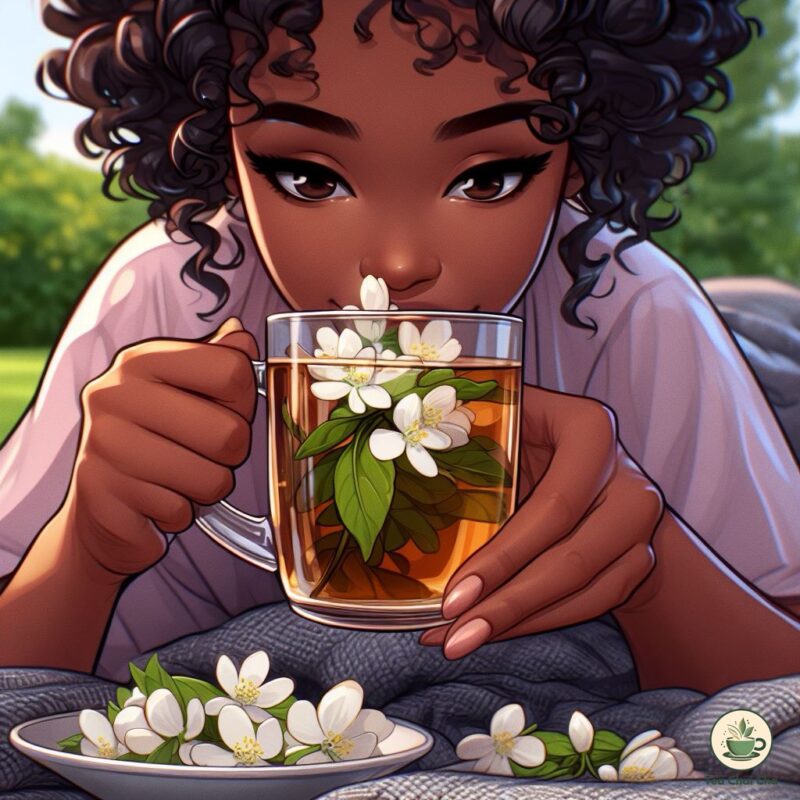Jasmine tea has a really fascinating history that goes way back to China’s Song Dynasty. Back then, it was like a special treat only for the royal family.
You can imagine how fancy it was, with the flowery smell of jasmine mixing with the cozy tea.
This cool tradition has stuck around for a super long time.
Nowadays, jasmine tea is a classic favorite that people all over the world really like.
You can have it nice and hot when it’s chilly out or icy cold when it’s super sunny.
So, today, I’m gonna give you a really simple and easy-to-follow recipe to make jasmine green tea.
What Is Jasmine Tea?
Jasmine tea, specifically jasmine green tea, is a delightful and aromatic drink that’s made by combining green tea leaves with jasmine flowers.
It’s a bit like when you add a splash of flavor to your water. But in this case, it’s all about infusing the lovely scent and taste of jasmine into the green tea.
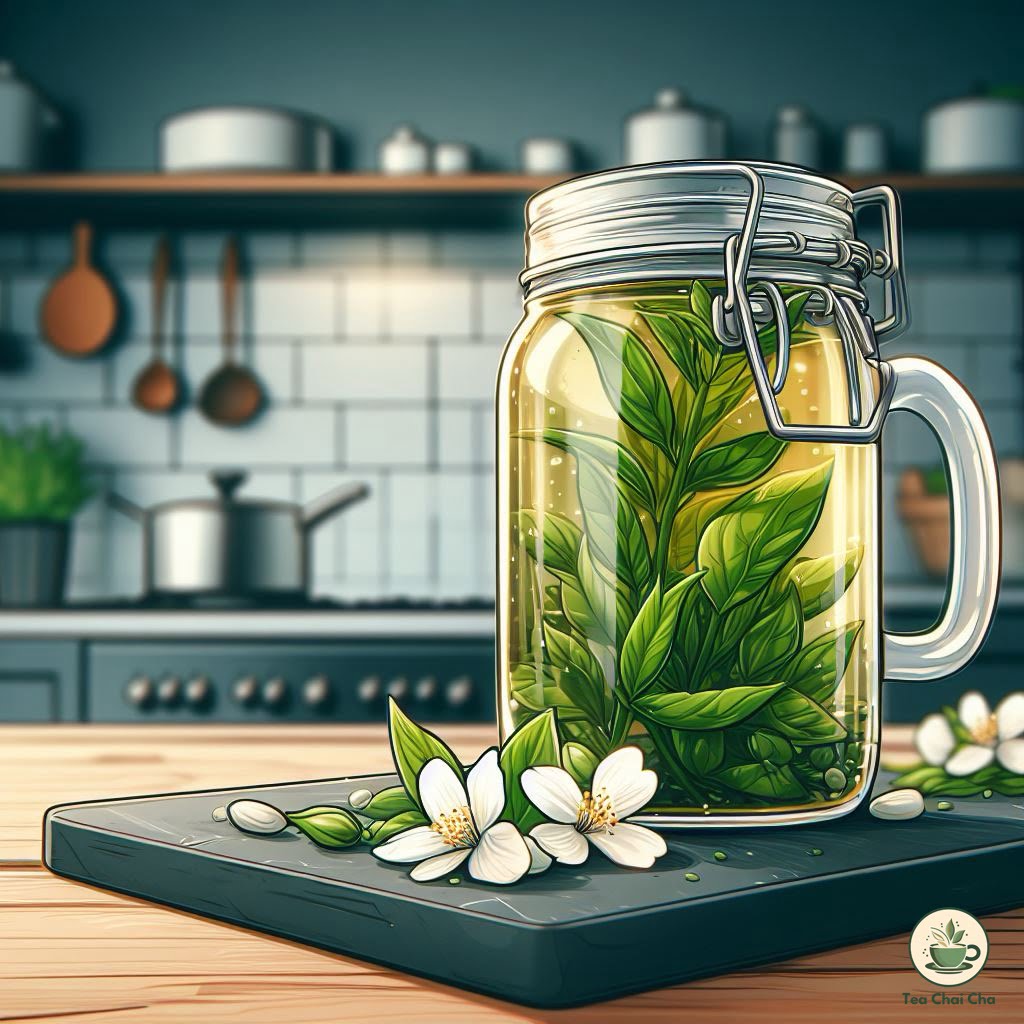
How is Jasmine Tea Made?
Here’s how they make it: The jasmine flowers are harvested and stored until they’re ready to bloom, usually at night when they release their strongest fragrance.
The tea leaves are carefully layered with these fragrant flowers and left together overnight.
During this time, the tea leaves absorb the sweet and flowery aroma of the jasmine blossoms.
The next day, the jasmine flowers are removed, and the tea leaves are all set to be brewed.
When you steep the jasmine tea, the hot water makes the tea leaves open up and release their flavors.
This is when you get that wonderful combination of the refreshing green tea taste along with the soothing floral scent of jasmine.
People often enjoy jasmine green tea not just for its taste, but also for the calming and pleasant feeling it can bring.
And if you’re someone who enjoys different flavors and aromas in your tea, jasmine green tea might become a favorite treat for you!
Related – What Does Jasmine Tea Taste Like?
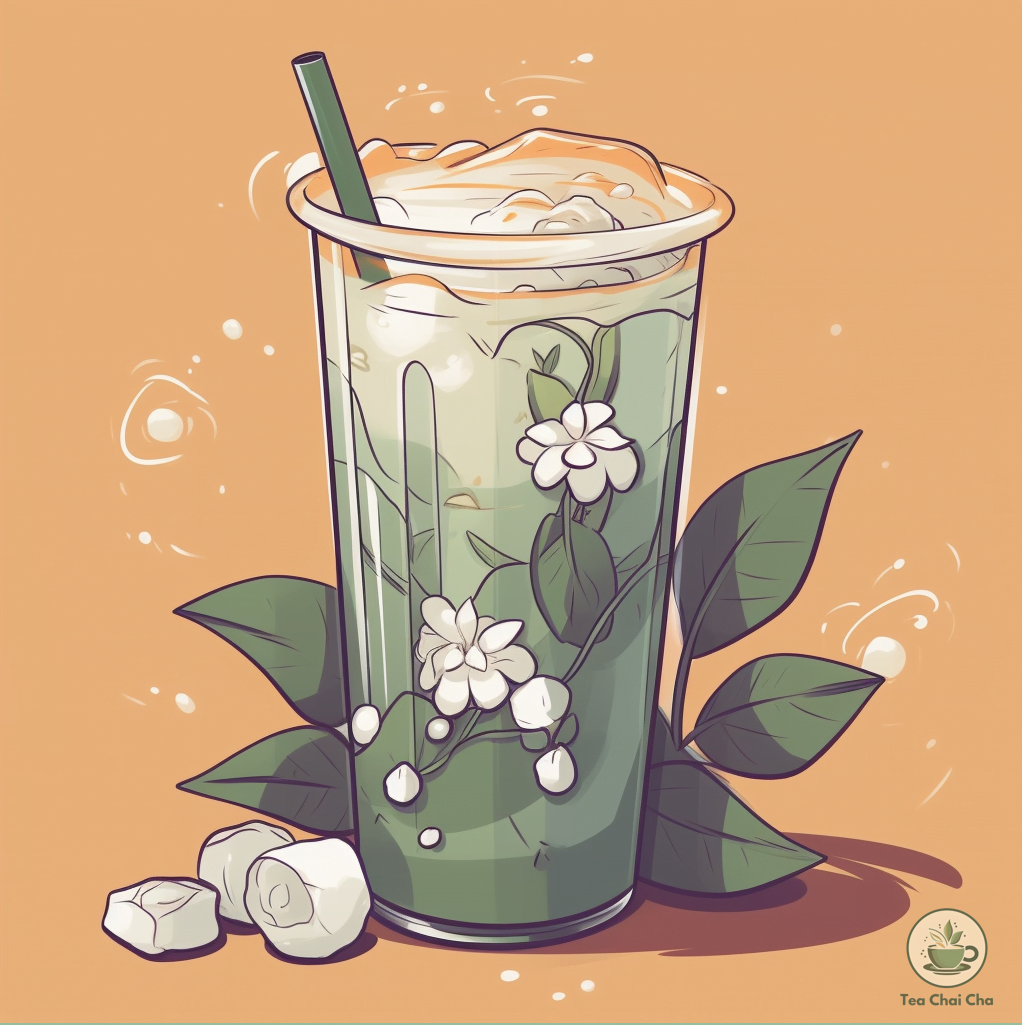
What is Jasmine Tea Good For? – 6 Health Benefits of Jasmine Tea for You!
Before I talk about the recipe, let’s check what jasmine tea has to offer for our health:
1. Packed with Antioxidants
Did you know that jasmine flowers are loaded with powerful antioxidants?
These special compounds, along with the antioxidants called catechins in green tea, shield your cells from harm.
By doing this, they lower your chances of getting chronic diseases.
2. Happy Heart Helper
Your heart will thank you for sipping jasmine tea. It’s the green tea inside that’s doing the magic.
Those antioxidants from green tea team up to protect your heart from stress.
They also help control bad cholesterol and blood pressure, both big troublemakers for your heart.
3. Brain’s Best Buddy
The catechins in jasmine tea’s green tea are like bodyguards for your brain.
They fend off problems by fighting inflammation and stress.
This keeps your brain safer from diseases that can sneak up on you.
4. Focus Booster
Feeling a bit fuzzy? The green tea in jasmine tea carries a little caffeine to perk you up.
This helps you stay sharp and focused, especially when things get busy.
5. Calm Companion
Ever heard of L-theanine? It’s in green tea, and it’s like a gentle hug for your body and mind.
Imagine feeling less anxious and stressed – that’s the magic of jasmine tea at work.
6. Blood Sugar Support
If you’re worried about blood sugar or diabetes, jasmine tea might lend a hand.
Green tea’s catechins could help your body handle glucose better, and those antioxidants are here to help too.
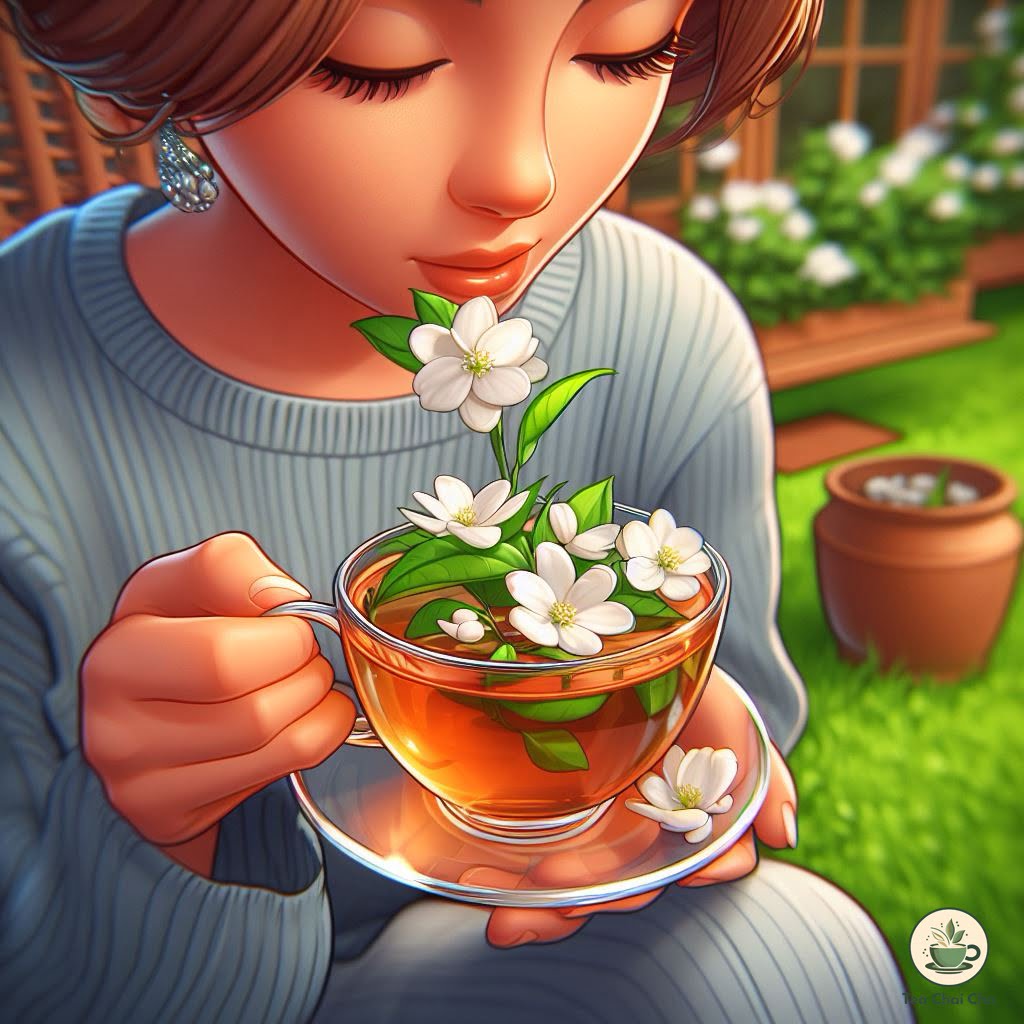
What You Need to Make Jasmine Tea
When making a delicious cup of jasmine green tea, you’ll need a few essential ingredients to ensure it turns out just right.
Here’s what you need:
1. Jasmine Green Tea Leaves or Tea Bags
The heart of your jasmine tea is, of course, the tea itself.
You can choose between loose jasmine green tea leaves or pre-packaged tea bags.
Loose leaves generally offer a more authentic and flavorful experience, while tea bags are convenient and easy to use.
2. Water
Use fresh, clean water. The quality of the water affects the taste of your tea.
Filtered or spring water is ideal, but tap water that doesn’t have a strong taste or odor can work too.
3. Teapot or Teacup
You’ll need a vessel to brew your tea.
A teapot or a teacup with a lid is perfect for steeping and retaining the fragrant aroma.
4. Tea Infuser (Optional)
If you’re using loose tea leaves, a tea infuser or a tea ball will come in handy. This helps contain the leaves while allowing them to steep freely.
Optional Additions
While the above ingredients are essential for brewing a basic cup of jasmine green tea, you can also enhance your experience with these optional additions:
1. Honey or Sugar
For a touch of sweetness, consider adding honey or sugar. Adjust the amount to your taste.
2. Lemon or Citrus Slices
A squeeze of lemon or a slice of citrus can brighten up the flavors of your jasmine tea.
3. Mint Leaves
Fresh mint leaves can add a refreshing twist to your tea, creating a delightful jasmine-mint blend.
4. Milk or Cream
Some people enjoy jasmine green tea with a splash of milk or cream for a creamy, comforting taste.
5. Thermometer
If you’re particular about water temperature, a thermometer can help ensure your water is at the ideal temperature for brewing jasmine green tea (around 175-185°F or 80-85°C).
Learn more about Tea Accessories and Their Uses.
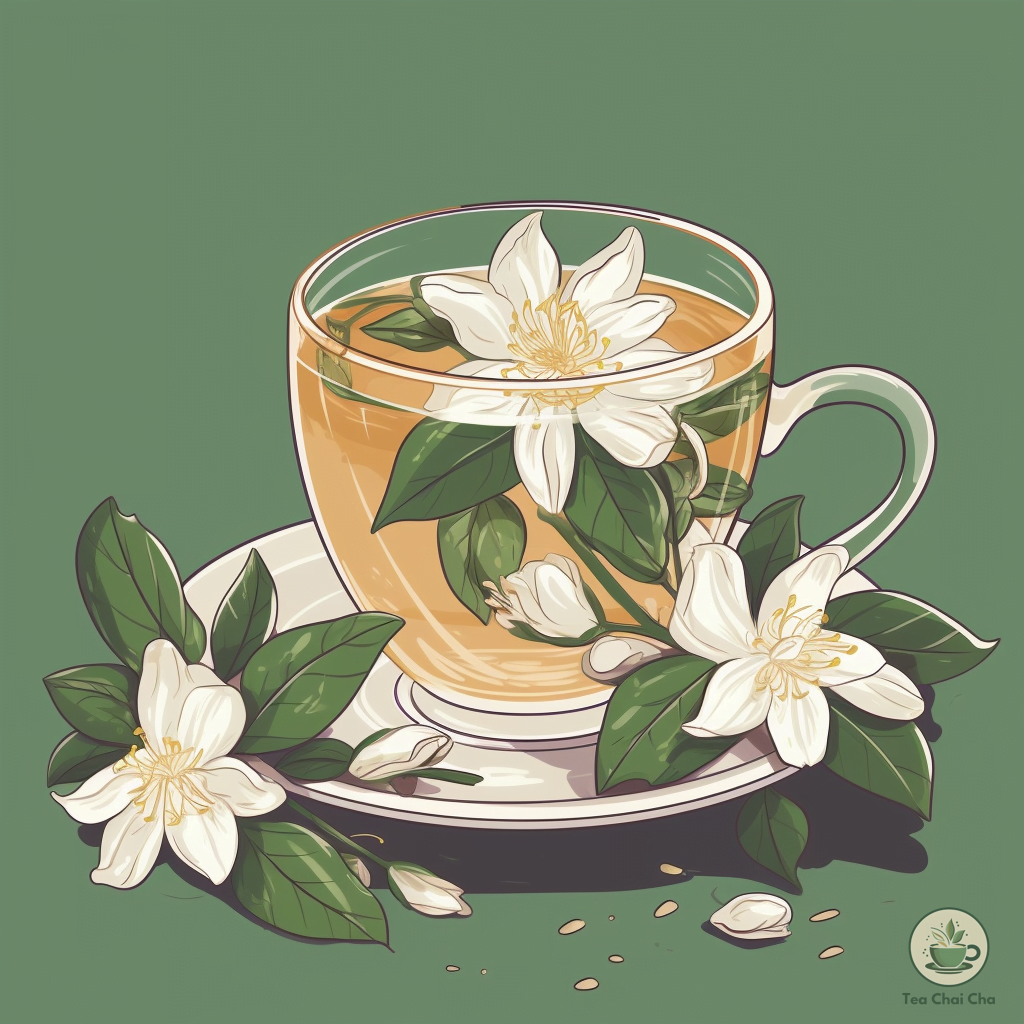
How to Make Jasmine Green Tea: Step-by-Step Guide
Jasmine green tea is a delightful and fragrant beverage that combines the soothing qualities of green tea with the delicate aroma of jasmine flowers.
Making this tea at home is a wonderful way to enjoy its unique flavor.
Let’s walk through the process step by step.
Step 1: Gather Your Ingredients
To make a cup of jasmine green tea, you’ll need the following:
- Jasmine Green Tea Leaves: Choose high-quality loose leaf tea for the best flavor. About 1 to 2 teaspoons of tea leaves per cup should be sufficient.
- Water: Fresh, filtered water is best. Avoid using water that has been sitting for too long or has an odd taste.
- Teapot or Infuser: You’ll need something to steep the tea leaves in. A teapot with an infuser basket works well, but you can also use a tea infuser ball.
Step 2: Boil the Water
Boil water in a kettle or on the stovetop.
The water temperature is crucial for green tea.
It’s recommended to bring the water to around 175°F (80°C) to 185°F (85°C).
If you don’t have a thermometer, let the water cool for a few minutes after boiling before using it.
Step 3: Preheat Your Teapot
If you’re using a teapot, pour a bit of hot water into it to warm it up.
This helps maintain the temperature of the tea during steeping.
Step 4: Add Jasmine Green Tea Leaves
Place the jasmine green tea leaves into the infuser basket of your teapot or directly into your cup.
Use about 1 to 2 teaspoons of tea leaves per cup, but feel free to adjust according to your taste preferences.
Step 5: Pour in the Water
Carefully pour the hot water over the tea leaves.
Ensure that the leaves are fully submerged in the water.
If using a teapot, cover it with the lid to keep the heat in.
Step 6: Steep the Tea
Allow the tea leaves to steep in the hot water for about 2 to 3 minutes.
Steeping for too long can make the tea bitter, so be mindful of the time.
The jasmine aroma will infuse into the tea, creating a wonderful blend of flavors.
Step 7: Enjoy Your Tea
Once the steeping time is up, remove the tea leaves from the water.
If using an infuser basket, simply lift it out.
If you’ve steeped the leaves directly in the cup, use a small strainer to catch the leaves as you pour the tea into your cup.
Take a moment to inhale the delightful aroma of your jasmine green tea.
Sip slowly and savor the gentle, floral notes combined with the refreshing taste of green tea.
Optional: Sweeten or Garnish
If you prefer your tea sweet, you can add a bit of honey, sugar, or another sweetener of your choice.
Some people also enjoy a slice of lemon or a sprig of mint as a garnish.
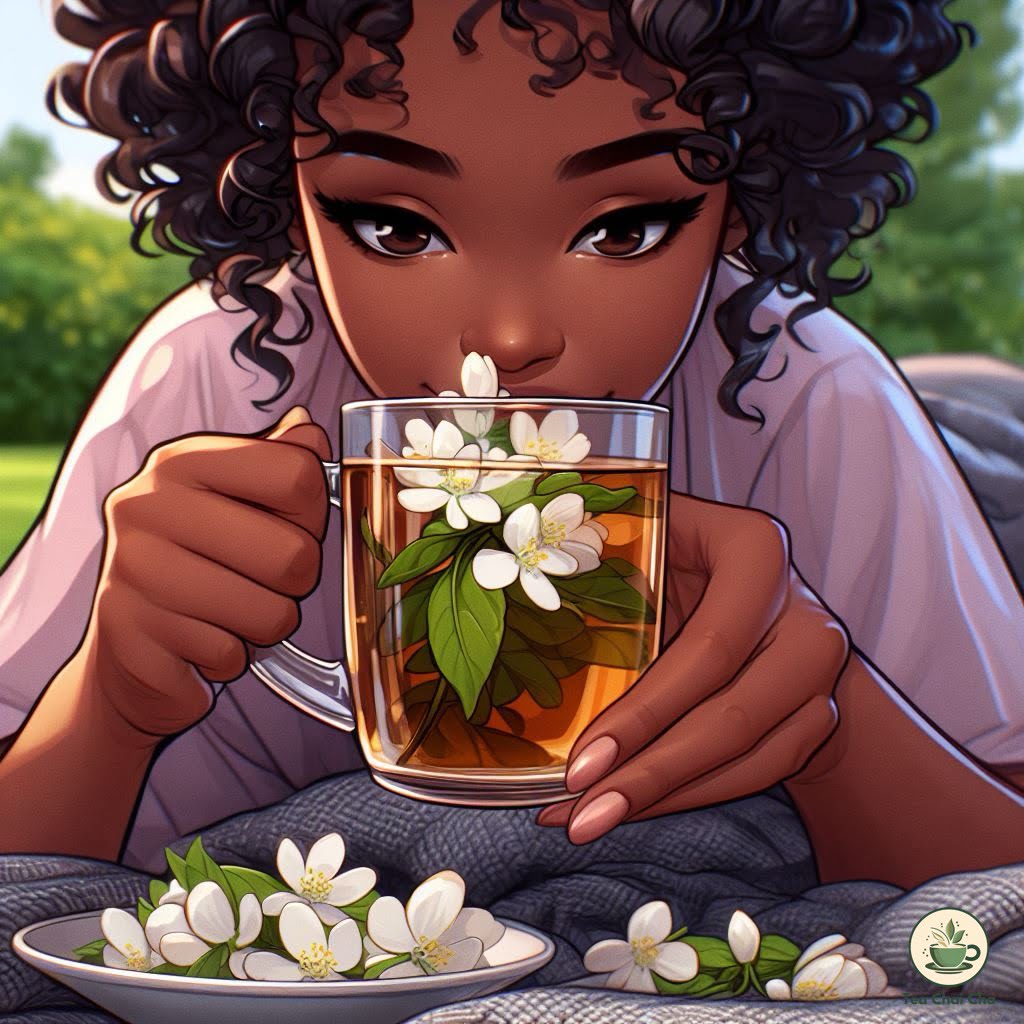
Jasmine Green Tea: Enjoy Hot or Cold?
When it comes to savoring the delightful flavors of jasmine green tea, there’s a choice to make: should you enjoy it hot or cold?
Each option brings its own unique taste and experience.
Let’s explore both ways to enjoy this fragrant tea!
1. Hot Jasmine Tea
Hot jasmine tea is a wonderful choice when you’re looking for a calming and serene moment.
It’s perfect for unwinding after a busy day or enjoying a peaceful morning ritual.
The warmth of the tea can be particularly comforting during colder seasons.
2. Cold Jasmine Tea
Cold jasmine tea is a fantastic choice for warmer days or when you’re seeking a refreshing beverage.
It’s like a refreshing sip of nature’s goodness, perfect for picnics, outdoor gatherings, or simply staying hydrated in style.
It’s All About Mood
Remember, there’s no right or wrong choice here – it’s all about personal preference.
You can even try brewing a batch of jasmine tea and enjoying it both ways to fully appreciate the diverse flavors and sensations it has to offer.
Brewing Guide for Jasmine Tea (Hot and Cold)
Here’s a simple table outlining the brewing time and temperature for both hot and iced jasmine tea:
| Tea Type | Water Temperature | Brewing Time |
| Hot Jasmine | 175-185°F (80-85°C) | 2-3 minutes |
| Iced Jasmine | 175-185°F (80-85°C) | 2-3 minutes (hot), then chill and serve over ice |
When making hot jasmine tea, I usually heat water to around 175-185°F (80-85°C).
Then, I steep the jasmine tea leaves for about 2-3 minutes. This gives the tea a delicate and aromatic flavor without making it too strong.
For a refreshing glass of iced jasmine tea, I follow a similar process.
I first brew the tea with hot water at the same temperature range of 175-185°F (80-85°C) for 2-3 minutes.
After brewing, I let the tea cool down before transferring it to the refrigerator to chill.
Once it’s cold, I pour it over a glass of ice and enjoy!
How to Make Jasmine Iced Tea
Jasmine green tea is easy to make.
Here are two methods: one for making it cold and another for a hot version.
Iced Method
For the Iced Jasmine Tea, you’ll need:
- Jasmine green tea bags (2 bags)
- Water (4 cups)
- Sweetener (like honey or sugar, to taste)
- Ice cubes
Here’s what you do:
- Boil the water and allow it to cool for a couple of minutes until it reaches around 175°F (80°C).
- Place the jasmine tea bags in a pitcher.
- Pour the hot water over the tea bags.
- Let the tea steep for about 3-4 minutes for a mild flavor. You can adjust the steeping time to your preference.
- Remove the tea bags and sweeten the tea while it’s still warm. Stir until the sweetener dissolves.
- Let the tea cool to room temperature, then place it in the fridge to chill.
- Once the tea is chilled, serve it over ice cubes in glasses.
Cold Brew Method
For the Cold Brew Jasmine Tea, you’ll need:
- Jasmine green tea leaves (2 teaspoons)
- Cold water (4 cups)
- Sweetener (optional)
- Ice cubes
Follow these steps:
- Put the jasmine tea leaves in a pitcher.
- Add cold water to the pitcher and give it a gentle stir.
- Cover the pitcher and place it in the fridge for about 4-6 hours or overnight for the flavors to infuse.
- Once the cold brew is ready, strain out the tea leaves.
- Sweeten the cold brew if desired, stirring until the sweetener is well mixed.
- Serve the cold brew jasmine tea over ice cubes.
My Experience!
I personally enjoy the cold brew method because it gives the tea a smooth and refreshing flavor without any bitterness.
It’s perfect for hot days or when you want a milder tea taste.
If you prefer a stronger taste, you can adjust the tea-to-water ratio or steeping time accordingly.
Whichever method you choose, I’m sure you’ll end up with a delightful glass of Jasmine Iced Tea that’s perfect for sipping and relaxing.
Factors That Affect the Flavor of Jasmine Tea
Worried about your jasmine green tea not vibing as it should?
Well, there are certain factors that can impact its floral and unique taste:
1. Quality of Tea Leaves
The flavor of jasmine green tea largely depends on the quality of the tea leaves used.
Higher-quality leaves tend to have a more delicate and nuanced flavor.
Look for tea labeled as “loose-leaf” rather than tea bags for better flavor.
2. Jasmine Scenting Process
The way jasmine scent is infused into the tea leaves plays a big role.
Some teas are scented multiple times with fresh jasmine flowers, creating a stronger aroma and flavor.
Others might use jasmine essence or flavorings, resulting in a milder taste.
3. Scenting Duration
The length of time the tea leaves are exposed to jasmine flowers affects the intensity of the flavor.
Longer scenting times usually result in a more potent jasmine taste, while shorter times lead to a subtler flavor.
4. Tea-to-Flower Ratio
The proportion of jasmine flowers to tea leaves matters.
A higher ratio of jasmine flowers can make the flavor stronger, while a lower ratio will be more balanced between the green tea and jasmine.
5. Harvest Timing
The season in which the tea leaves are harvested can impact flavor.
Spring-harvested leaves are often considered the best due to their tender and fresh nature, resulting in a smoother and more delicate taste.
6. Origin of Tea
Different regions produce different tasting teas.
For instance, jasmine green tea from China might have a slightly different flavor profile compared to one from Taiwan.
You might want to explore different origins to find your preferred taste.
7. Storage Conditions
Proper storage is crucial for preserving flavor.
Keep your jasmine green tea away from strong odors, humidity, and light to maintain its taste and aroma.
8. Brewing Time and Temperature
How you brew your tea matters.
Using water that’s too hot or steeping for too long can make the jasmine flavor overpowering or bitter.
Generally, for green tea, water around 175°F (80°C) and a steeping time of 2-3 minutes is recommended.

How to Make Jasmine Tea Taste Good – 11 Drinks to Try!
Jasmine green tea is known for its delicate floral aroma and soothing taste.
However, if you’re looking to take your jasmine tea experience up a notch, there are several simple and delicious ways to do so.
Here are some options to consider:
1. Sweeten with Honey or Agave
Adding a touch of sweetness can complement the floral notes of jasmine tea.
I personally love stirring in a teaspoon of honey or agave syrup into my cup of jasmine tea.
The natural sweetness enhances the overall flavor profile and creates a delightful balance.
2. Citrus Zest Infusion
Citrus fruits like lemon, orange, or even a hint of lime can brighten up the subtle flavors of jasmine tea.
Drop a few strips of citrus zest into your tea while it’s steeping.
The citrus oils will mingle with the floral aroma, giving your tea a refreshing twist.
3. Minty Freshness
For a cooling and invigorating twist, try adding a few fresh mint leaves to your jasmine tea.
The minty aroma blends harmoniously with the floral scent, creating a revitalizing and aromatic cup of tea.
4. Fruit Infusions
Experiment with fruit-infused jasmine tea by dropping in slices of fruits like peach, apricot, or berries.
As the tea steeps, the natural sweetness and flavors of the fruits will infuse into the tea, resulting in a unique and delightful taste.
5. Vanilla Elegance
A touch of vanilla extract or even a vanilla bean pod can transform your jasmine tea into a luxurious treat.
The warm and creamy essence of vanilla pairs wonderfully with the delicate jasmine aroma.
6. Coconut Creaminess
For a tropical twist, consider adding a splash of coconut milk or coconut cream to your jasmine tea.
The creamy coconut flavor melds harmoniously with the floral notes, creating a rich and indulgent experience.
7. Iced Jasmine Tea Variations
Don’t limit yourself to just hot tea.
Jasmine tea makes for a wonderful base in various chilled beverages. Here are a few ideas:
- Jasmine Iced Tea: Brew jasmine tea as usual, let it cool, and pour it over ice. Add a squeeze of lemon or a drizzle of honey for extra flavor.
- Jasmine Tea Lemonade: Mix equal parts of brewed jasmine tea and freshly squeezed lemonade. Adjust the ratio to your taste preferences.
- Jasmine Green Tea Smoothie: Blend cooled jasmine tea with your favorite fruits, a handful of spinach, and a touch of yogurt for a healthy and refreshing smoothie.
8. Jasmine Milk Tea
Jasmine milk tea combines the soothing aroma of jasmine with the rich creaminess of milk.
To make it, brew a strong cup of jasmine green tea and then add your choice of milk, whether it’s dairy milk, almond milk, or oat milk.
You can sweeten it with a touch of honey or sugar, depending on your preference.
The milk adds a velvety texture that complements the floral notes of jasmine. It creates comforting blend.
Related – What Does Jasmine Milk Tea Taste Like?
9. Jasmine Bubble Tea
For a fun and refreshing twist, consider making jasmine bubble tea.
Brew a strong cup of jasmine green tea and let it cool.
Add cooked tapioca pearls (also known as boba) to the bottom of a glass, pour in the cooled jasmine tea, and add a bit of simple syrup for sweetness.
Top it off with ice, and you’ve got a delightful beverage with chewy pearls that add a unique texture to the experience.
Related –
10. Jasmine Chai Latte
If you’re in the mood for something spicier, try a jasmine chai latte.
Brew your jasmine green tea and then heat it with a mixture of milk and your favorite chai spices, like cinnamon, cardamom, and ginger. Strain and sweeten as desired.
This fusion creates a warm and aromatic drink that marries the floral essence of jasmine with the flavors of chai.
11. Jasmine Tea Latte with Vanilla
A jasmine tea latte with a hint of vanilla offers a delicate and subtly sweet flavor profile.
Brew your jasmine green tea and heat it with milk until warm.
Add a splash of vanilla extract and a touch of sweetener if desired.
The vanilla enhances the floral notes of the tea, creating a well-balanced and soothing beverage.

Jasmine Tea Food Pairing
As a devoted fan of jasmine green tea, I’m excited to share some scrumptious food pairing options that will enhance your sipping pleasure.
The delicate floral aroma and soothing flavor of jasmine tea can be wonderfully complemented by the right culinary choices.
Let’s explore some delectable options below.
1. Citrus Fruits
When I’m enjoying a cup of jasmine green tea, I find that the zesty and refreshing nature of citrus fruits like oranges, lemons, and grapefruits perfectly harmonize with its floral notes.
The tanginess of these fruits provides a lively contrast that awakens the palate.
2. Butter Cookies
If you’re in the mood for a delightful treat, consider pairing your jasmine green tea with buttery cookies.
Their mild sweetness and smooth texture won’t overpower the tea’s delicate flavors, creating a balanced and comforting experience.
3. Sushi Rolls
For a more substantial pairing, sushi rolls are an excellent choice.
The clean, umami-rich flavors of sushi, whether with fresh fish or vegetarian fillings, complement the floral essence of jasmine green tea surprisingly well.
The contrast between the two is both satisfying and intriguing.
4. Almonds or Cashews
Nuts, such as almonds or cashews, can add a delightful crunch to your tea time.
Their mild nuttiness aligns beautifully with jasmine tea’s subtle character, making for a satisfying and wholesome pairing.
5. Jasmine Rice Dishes
To create a symphony of jasmine flavors, consider enjoying your tea with jasmine rice-based dishes.
Whether it’s a fragrant Thai coconut curry or a simple stir-fry, the shared name and underlying floral notes create a harmonious culinary experience.
6. Lavender Shortbread
For a truly unique pairing, indulge in lavender-infused shortbread cookies.
The delicate floral essence of lavender echoes the jasmine tea’s aromatic profile, resulting in a charming and aromatic duo.
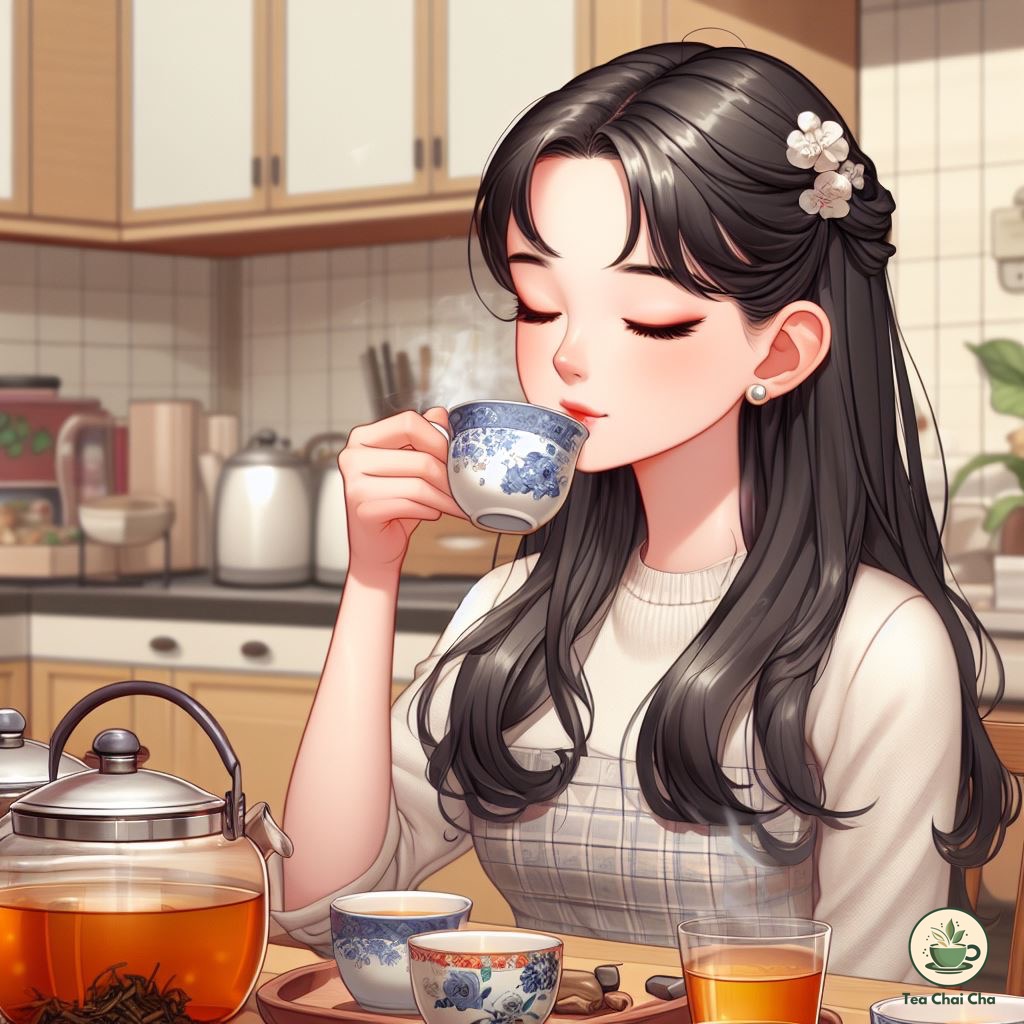
When to Drink Jasmine Tea
So, what’s the best time to enjoy jasmine green tea for its benefits?
Here are some options to consider:
Morning Wake-Up
Starting your day with a cup of jasmine green tea can provide a gentle energy boost.
The subtle caffeine content can help you feel alert without the jitters that come with strong coffee.
Plus, the soothing aroma can set a positive tone for the day.
After Meals
Having jasmine green tea after meals can aid digestion.
The tea’s compounds might help your body process food more efficiently.
It can also serve as a refreshing palate cleanser after a hearty meal.
Midday Break
Taking a break during the middle of the day?
Enjoying a cup of jasmine green tea can be a great way to relax and recharge.
The calming scent and flavor can provide a pleasant escape from daily tasks.
Pre-Workout
If you’re looking for a pre-workout drink, jasmine green tea can be a good option.
It offers a mild energy lift to support your exercise routine.
Just make sure to drink it about 30 minutes before your workout for the best effect.
Stress Relief
Feeling stressed?
Jasmine green tea’s natural aroma has been associated with relaxation and stress reduction.
Taking a moment to sip this tea can be a simple way to calm your mind and ease tension.
Before Bed
While jasmine green tea does contain some caffeine, it’s significantly less than coffee.
If you’re sensitive to caffeine, having a cup of jasmine green tea in the evening might not disrupt your sleep as much as other caffeinated beverages.
Social Gatherings
Jasmine green tea can be a delightful choice for social occasions.
Its floral fragrance and light flavor can make it an enjoyable and unique option to share with friends and family.
Remember, the timing of when you drink jasmine green tea ultimately depends on your personal preferences and how your body responds to caffeine.
If you’re sensitive to caffeine, it’s a good idea to avoid drinking it too close to bedtime.
Experiment with different times to find what works best for you and your lifestyle.
Related to Tea Making

Jasmine Tea Recipe
Recipe by Tania FaysalCourse: DrinksCuisine: Chinese, South East Asian2
servings5
minutes3
minutes2-5
kcal8
minutesHomemade Jasmine Tea: An Aromatic Retreat for Two!
Ingredients
2 teaspoons jasmine tea leaves
2 cups hot water (around 175°F or 80°C)
Optional: honey or sweetener of your choice (to taste)
Ice cubes (for serving)
Fresh jasmine flowers or orange slices for garnish (optional)
Directions
- Boil water: Bring 2 cups of water to a boil.
- Rinse teapot: Rinse your teapot or teacups with hot water to warm them up.
- Add jasmine tea leaves: Place 2 teaspoons of jasmine tea leaves into a teapot or a tea infuser.
- Pour hot water: Pour the hot water over the jasmine tea leaves in the teapot.
- Steep the tea: Let the jasmine tea steep for about 3-5 minutes to extract its flavors. The optimal steeping temperature is around 175°F (80°C).
- Strain and serve: After steeping, strain the tea leaves and pour the brewed jasmine tea into teacups or glasses filled with ice cubes.
- Sweeten to taste: If desired, add honey or your preferred sweetener to the brewed tea and stir until it dissolves.
- Garnish and enjoy: Garnish the jasmine tea with fresh jasmine flowers or orange slices, if desired. Serve the tea chilled over ice cubes.
Recipe Video
Frequently Asked Questions (FAQs)
What does jasmine tea taste like?
Jasmine tea has a delicate and soothing taste with floral notes. It’s often described as refreshing and slightly sweet, thanks to the fragrance of jasmine blossoms mixed with the earthiness of green tea.
Does jasmine tea have caffeine?
Yes, jasmine tea contains 25 mg of caffeine per cup. The green tea base contributes caffeine to the blend. However, the caffeine level is generally lower compared to black tea or coffee.
Is jasmine a real tea?
Jasmine tea is a flavored tea made by blending jasmine blossoms with tea leaves, usually green tea. While jasmine itself is not a tea plant, the combination creates the popular jasmine tea.
How many calories are in jasmine tea?
A typical cup of jasmine tea has very few calories, usually around 2-5 calories per 8-ounce serving. This can vary slightly based on the brand and any added ingredients.
Can I make tea with fresh jasmine?
Yes, you can make tea with fresh jasmine! Using fresh jasmine blossoms to infuse your tea is a wonderful idea. Just remember to remove the blossoms after a few minutes to avoid an overpowering taste.
How to make your own jasmine green tea?
Making jasmine green tea is easy. Brew a cup of green tea and add fresh jasmine blossoms or dried jasmine flowers to infuse their flavor. Let them steep for a few minutes, strain, and enjoy!
Can you make tea from any jasmine plant?
Not all jasmine varieties are suitable for making tea. The most commonly used is Jasminum sambac. Make sure the jasmine you’re using is safe and flavorful for tea-making.
What part of jasmine is used for tea?
For jasmine tea, the blossoms are used to add their fragrance and flavor. These blossoms are often mixed with green tea leaves, allowing the flavors to meld during the drying process.

